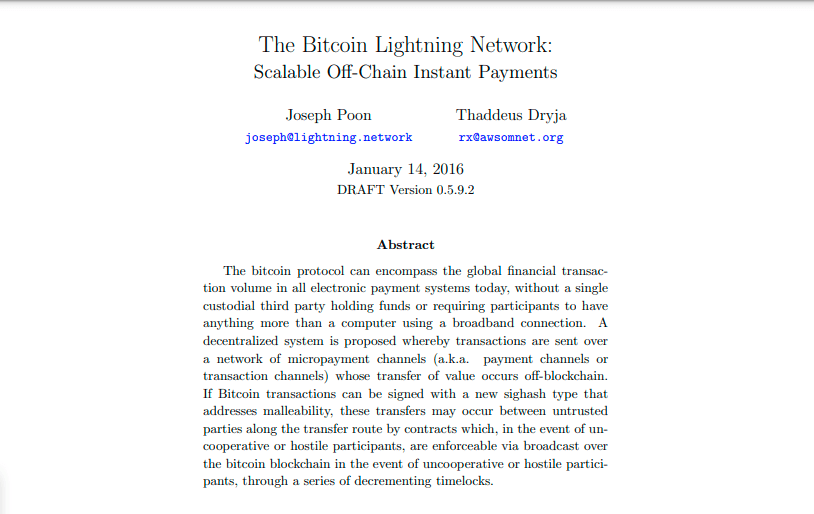The Lightning Network Whitepaper is a foundational document in the world of Bitcoin, proposing a second-layer solution to address Bitcoin’s scalability, speed, and transaction cost challenges.
Authored by Joseph Poon and Thaddeus Dryja in 2016, the whitepaper outlines how off-chain micropayment channels can enable instant, low-fee transactions while preserving Bitcoin’s decentralized ethos.
Below you can download the original PDF:
Table of Contents
What Is the Lightning Network?
The Lightning Network is a second-layer protocol built on top of the Bitcoin blockchain.
Its main goal is to allow fast, scalable, and inexpensive transactions by moving most activity off the main blockchain and onto a network of payment channels.
These channels let users transact directly with each other, only settling the final balances on the Bitcoin blockchain when the channel is closed.
Thanks to Lightning, users can send and receive bitcoin instantly at minimal cost. Users can choose which of of the wide variety of lightning wallets suits them best. If they feel comfortable with custodial lightning providers or prefer being in control of their own keys is up to each user.
While convenience poses a lack of control, managing a lightning wallet yourself comes with unique technical responsibilities and is certainly not something done on a whim.
Key Features Outlined in the Lightning Network Whitepaper
- Micropayment Channels: Lightning users open channels by locking funds on the blockchain, then exchange unlimited off-chain transactions.
- Instant Settlement: Payments are nearly instantaneous, making Bitcoin suitable for everyday purchases like coffee or online microtransactions.
- Low Fees: By reducing the number of on-chain transactions, the Lightning Network drastically lowers transaction costs.
- Privacy: Off-chain transactions are not broadcast to the public blockchain, enhancing user privacy.
How the Lightning Network Works
- Channel Creation: Two parties open a payment channel by creating a multi-signature Bitcoin address, funded by both participants.
- Off-Chain Transactions: Within the channel, users can send unlimited payments by updating the balance sheet, without touching the blockchain.
- Channel Closure: When the parties finish transacting, they close the channel. The final balance is settled on the blockchain, ensuring security and transparency.
Security Mechanisms
- Smart Contracts: The Lightning Network uses Bitcoin’s scripting language to enforce rules, such as penalizing dishonest participants.
- Time Locks and Hash Locks: These cryptographic tools ensure that funds are only released under agreed conditions, protecting users from fraud.
- Breach Remedy Transactions: If someone tries to cheat by broadcasting an outdated transaction, the other party can claim all the funds as a penalty.
Benefits of the Lightning Network
- Scalability: Enables Bitcoin to process millions of transactions per second, far surpassing traditional payment networks.
- Reduced Blockchain Congestion: By moving most transactions off-chain, the Lightning Network helps keep the Bitcoin blockchain efficient and decentralized.
- Cross-Chain Payments: The protocol can be extended to other blockchains, allowing atomic swaps between different cryptocurrencies.
Limitations and Risks
- Channel Capacity: The maximum amount transferable is limited to the funds initially locked in the channel.
- Need for Online Presence: Participants must monitor the network to prevent fraud, though “watchtower” services can help.
- Complexity: The technology is still maturing and may require technical expertise to use securely.
Conclusion
The Lightning Network Whitepaper is a landmark in blockchain innovation, offering a practical path to scaling Bitcoin for mass adoption.
By leveraging off-chain payment channels, it unlocks instant, low-cost, and scalable transactions while preserving Bitcoin’s core principles. As the Lightning Network continues to evolve, its whitepaper remains essential reading for anyone interested in the future of decentralized finance.
















